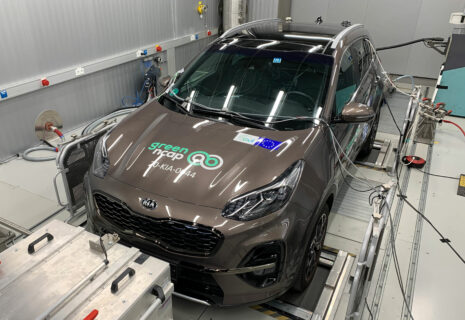Kia Sportage 1.6 CRDi diesel 4x4 automatic
2020
22%
3.4
10
Clean Air Index
3.2
10
Energy Efficiency Index
0.1
10
Greenhouse Gas Index
| Laboratory Tests | NMHC | NOX | NH3 | CO | PN | |
|---|---|---|---|---|---|---|
| 5.610 | Cold Test | |||||
| 6.410 | Warm Test | |||||
| 0.010 | Cold Ambient test | |||||
| 0.010 | Highway | |||||
| Road test | ||||||
| 5.210 | On-Road Drive | |||||
| 0.08 | On-Road Heavy Load | |||||
| 3.65 | On-Road Light Load | |||||
| 2.65 | On-Road Short Trip | |||||
| 1.02 | Congestion | |||||
| Robustness |
| Laboratory Tests | Energy | |||
|---|---|---|---|---|
| 4.510 | Cold Test | |||
| 5.110 | Warm Test | |||
| 1.710 | Cold Ambient test | |||
| 1.610 | Highway | |||
| Consumption | Driving Range | |||
| Average | 6.9l100 km | 915km | ||
| Worst-Case | 8.2l100 km | 756km | ||
| Greenhouse Gases | CO2 | N2O | CH4 | |
|---|---|---|---|---|
| 0.07 | Cold Test | |||
| 0.07 | Warm Test | |||
| 0.07 | Cold Ambient test | |||
| 0.57 | Highway |
Specifications
- Tested Car U5YPK812HLL86XXXX
- Publication Date 11 2020
- Vehicle Class Small SUV
- Emissions Class Euro 6d-Temp
- Tyres 245/45R19 98W
- Mass 1,744 kg
- Engine Size 1,598 cc
- Engine Power/Torque 100 kW/320 Nm
- Published CO2 161 g/km




































































































































Our verdict
Kia's compact SUV, the Sportage, has come a long way since the original version was launched in 1993. The car is tested here with the 1.6 diesel engine with 48V mild-hybrid technology. It has a comprehensive range of exhaust after-treatment, including selective catalytic reduction (SCR), a lean NOx trap catalyst and a diesel particulate filter (DPF). Nevertheless, with an overall rating of just 1½ stars, there is room for improvement. Carbon monoxide remains well below legislative limits under all test conditions and, under standard laboratory conditions, NOx emissions are adequately controlled. However, the vehicle is not robust in this regard and the more challenging tests lead to high values of NOx. With its permanent four wheel drive and a fairly high test mass, efficiency is not the best. But it is in the area of greenhouse gas emissions that the car performs most poorly. In particular, N2O emissions are high and this has a smothering effect on the car's score in this area. With an index of just 0.1 in this part of the assessment, the weighted index is dragged down and the car effectively loses half a star because of this aspect of its performance.